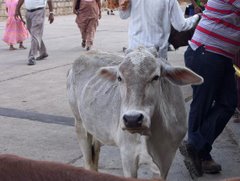Indian music
There is a parable attributed to the Buddha: A group of blind men are led to an elephant, each to a different part of the animal's body, and asked to describe what they feel. One feels the head; the next the ears; another, a tusk; the next, a foot; another, the tail, and so on. Each is told that the part to which he has access is the elephant, and so each man insists that he knows what an elephant is, when he can't see the entire animal.
So it goes with Indian music: Hearing any one of the dozens upon dozens of styles of popular, classical or folk music from India won't give you a full picture of Indian music. Each genre has its own history, evolution and performance style, and the music you hear in, for example, the temple dance tradition of the far eastern state of Orissa doesn't sound much at all like what you might hear a Rajasthani brass band play for a wedding in the northwest. Similarly, even the two main branches of classical music, Hindustani (North Indian) and Carnatic (South Indian) music are distinctly different entities, though both at their core are built on the twin principles of raga/ragam (melody) and tala/talam (rhythm).
And of course those descriptions don't even begin to broach the impact that filmi (movie) music has as the day-to-day soundtrack for well over a billion lives, the subcontinent's immensely rich and diverse folk music traditions.
When many European and North American world music fans think of Indian music, however, their thoughts most likely turn immediately to the work of artists like Ravi Shankar, Ali Akbar Khan and their students, who have done so much to popularize the sounds of India in the West. However, these artists' main tradition is only one current's worth of music—in fact, Shankar and Khan come from the same gharana (school) of playing, and learned from the same teacher. To this day, it's far easier in North America to find recordings and attend concerts of Hindustani classical music in mainstream outlets and venues than it is for any other Indian style, unless you venture into local "ethnic" community haunts. That is slowly changing, however. Indian music is so rich and diverse that once you are drawn in and get acclimated, you find endless pleasure...













1 comment:
very informative article.
Thanks .
Prashanth
Post a Comment